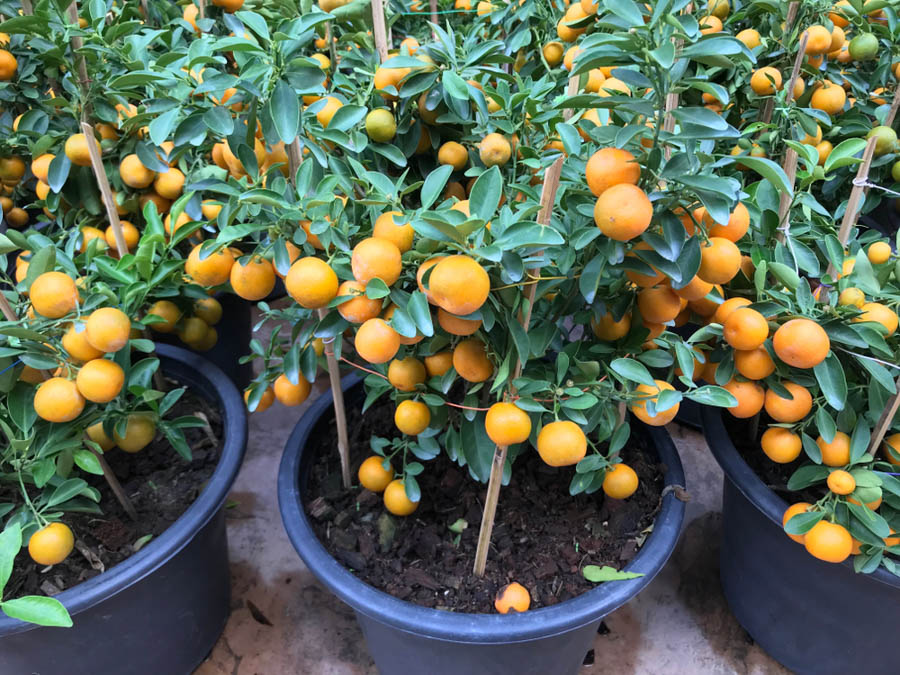Growing Orange Trees in Containers: Meeting the Challenges

With proper pruning and management, any variety of orange tree can be grown in a container, although trees may stay small and yields may be minimal unless trees are grown in very large pots. Use a soil mix of at least 30% sand, combined with soil and compost or well-rotted organic matter, in pots or containers that drain well. Potted citrus can be moved seasonally or as necessary to keep the tree in full sun or protect against cold.
Rootstock does not need to determine tree size, and technically, with regular pruning, any size of citrus tree can be maintained in a pot. Dwarf trees are preferable and may be slower to become rootbound than standard and semi-dwarf trees.
A number of challenges arise when growing orange trees in containers or any place root space is limited:
1) Root binding: It is inevitable with most potted citrus that roots will outgrow the available soil and space. Unlike deciduous fruit trees, citrus never lose their leaves or go fully dormant, so there is never an ideal time to remove trees from pots for root pruning. Root binding will cause most citrus in pots to decline within a few to several years as roots circle, girdle, exhaust available nutrients, and become so densely packed inside the pot that water and nutrients may not penetrate. Root binding is a common cause of stress, disease, pest infestation, and death in potted citrus.
To keep citrus alive and healthy indefinitely in pots, they must be moved to a larger pot with fresh soil about every 2 to 4 years; or removed and carefully root pruned during a time of year when the tree is not actively growing or fruiting and weather isn’t hot, then returned to the same pot with fresh soil. If roots are jarred or soil falls off while out of the pot, the tree may go into shock or die.
2) Salt burn: Minerals are added to most municipal water to prevent corrosion and extend the life of water pipes. When potted trees and plants are watered with city water, such as that coming in through landscape hoses or house faucets, some of the water evaporates, leaving minerals behind in the potted soil that tend to build up and become toxic to plants. The damage from this typically appears as dead, brown leaf edges and/or tips, which may extend to cover most or all of a leaf’s surface, and if allowed to persist and worsen, this will eventually kill almost any potted plant or tree.
To address salt burn, soil in pots must be flushed periodically to dissolve and remove mineral build-up. This can be accomplished by leaving a potted plant outdoors all day in rain for a few days per year; or by soaking potted plants in fresh water (city or otherwise) for a few hours, such as in a large bucket filled with water up to the brim of the pot, then flushed by running water through the potted soil for several minutes. Trees grown in pots under eaves or in areas protected from natural rainfall generally need to be flushed at least once or twice per year to avoid salt burn.
3) Anaerobic soil: Water becomes trapped in pots with poor drainage, and once oxygen in the water is depleted, anaerobic organisms multiply and produce foul-smelling byproducts that are toxic to plants. This may occur in pots or beneath the soil surface in poorly drained landscapes.
Pots should have large holes in the bottoms to allow for good drainage.
4) Soil dryness: Soil in pots may tend to dry quickly, and trees in containers may need much more frequent watering than if planted directly in the ground.
Watch for citrus leaves curling inward or appearing to change slightly in color as the lighter undersides become more visible, which indicate drought stress and early wilting and increase watering as appropriate.
5) Nutrient exhaustion: The small volume of soil in pots becomes exhausted and leached over months and years.
Maintain surface dressing of compost and amendments under mulch for potted trees, and consider using slow-release organic fertilizers if your potted trees and perennials show nutrient deficiencies.
GardenZeus provides gardening information customized by plant and zip code. Don’t know your GardenZeus zone? Click here.
Other articles of interest:
Orange Trees: Should They Have Companion Plants?
Getting Started with Citrus: Purchasing and Placing Your citrus Trees